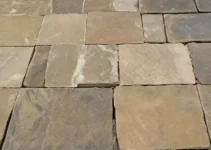Geo-Pavers are one of the most durable and aesthetic paving option for a driveway, patio or parking area. In fact, geo-pavers use a European interlocking paving brick design, which give them a beautiful look. In addition, their design allows rainwater to drain through them and the result is…no more water potholes.

Photo by C.O.S Design – Discover landscaping design ideas
The geopavers installation is simple but implies a pretty hard labor.
Steps to take:
1. Preparation: Before laying the pavers you should consider the following factors:
– You need a stable soil with a good drainage.
– The surface has to be level and structurally sound. If it is not, the installation of geopavers will require geo-textile fabric using. That will insure the stability of your construction.
– Make sure your project will meet all of the local government permits and engineering requirements.
– Check if you have easy access to the site. Geopavers are heavy and easy accessibility is critical.
2. Choose the geo-pavers: Geo-pavers come in a wide variety of sizes and shapes. Find the type, which is more suitable for your project. Check the manufacturer instruction. Each geo-paver type can have special installation requirements.
3. Determine the area you will be paving and find the number of pavers you will need: To find the area you need to multiply the width time the length.
- Divide the result with the paver size and you will find the approximately number of the pavers required.
You need also, base material, that can be crushed concrete material or rocks installed over compacted soil (an 8-inch thick layer).
The next is a layer of clean sand (1-inch). That will allow geo-pavers be leveled.
Fill material (clean sand or limestone aggregate) is use to fill the joints and cell of the pavers.
4. Clear and prepare the area for the paver installation: Remove any large rocks, bushes, plants and everything else that could be in the area where you will install the geo-pavers. Make sure there are no underground utilities such as phone, drain, pipe, cable etc. If there are, you need to relocate them.
5. Grade the subgrade area – about 12-inches depth (approx. 30.5 cm): This thickness can vary in accordance with the type of the geo-pavers and the kind of the base material used.
6. Compact the subgrade and then compact the added base material: This process have to be done according with your project and codes requirements.
7. Sprinkle a layer of sand 1-inch (2.5 cm) thick: This layer will be the setting bed for geo-pavers. Grade the concrete sand setting bad with a landscaping rake.
8. Use string lines for guidance: Start laying a row of pavers at the edge of the driveway or sidewalk and square it up, using a string line.
9. Lay the pavers and settle them taping with a rubber mallet: Lay the paver rows in accordance with the first row and check all the time if the joints are tights.
10. Cut any geo-paver that does not fit: Usually geo-pavers may differ in shape and size and these differences may result in a deviation from the straight line of the row. So, measure and cut any paver along the edge if it does not fit.
11. From time to time, check the levelness of the paved area: Using a straight board check the level and tap with the rubber mallet any raised paver or add some setting sand under an unstable paver.
12. Fill the pavers with clean sand or limestone aggregate: Usually clean sand is a good choice but special conditions require other materials.
13. Clean up the area: Sweep any excess of sand or other filling material.
Beautiful Gardens | How To Build A House (howtobuildahouseblog.com)

